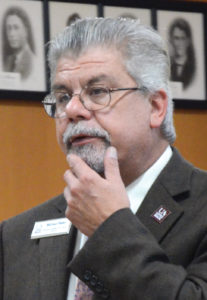
By Steve Brawner, © 2018 by Steve Brawner Communications, Inc.
Economics has been called the “dismal science,” so leave it to an economist to offer a dose of reality regarding Arkansas’ “record low unemployment rate.”
That rate is 3.5 percent, the lowest ever measured and one that is slightly lower than the national 3.7 percent rate.
Elected officials understandably brag about those numbers because they are much better than in the recent past – particularly October 2009, when 10 percent of Americans were unemployed. The Great Recession supposedly had ended in June that year, but nobody knew it – certainly not those 10 percent.
Dr. Michael Pakko, chief economist and state economic forecaster at the University of Arkansas at Little Rock’s Institute for Economic Advancement, offered a different take during his annual economic forecast Nov. 9. I heard him speak a couple of days earlier to an engineering association.
Pakko, whose overall forecast was positive, particularly regarding the next two years, is looking at another number – the labor force participation rate.
It tells us more. The unemployment rate measures only workers with a job or looking for one. The labor force participation rate includes people who aren’t trying to find one.
By that measurement, according to Pakko, a smaller percentage of people are actually working these days. In 2007 before the Great Recession, 63 percent of Arkansans ages 16 and over were in the labor force. This September, it was 57.4 percent. Nationally, the rate has dropped from 66 to 62.7 percent. Many of the departed are in their prime working years of ages 45-65. As Pakko told the engineers, “5 percent of the population of Arkansas has simply dropped out of the labor force altogether.”
There are several reasons the labor force participation rate is dropping. The baby boomers are aging and retiring, while young people are staying longer in school. The percentage of working women nationally stopped increasing around 2000.
Arkansas saw a big decline in manufacturing jobs in 2012, when the state, unlike the nation, suffered through a brief, double-dip recession. In fact, Arkansas has lost 30,000 construction and manufacturing jobs since a decade ago. While those losses have been counteracted by gains in the service sector, the bad news is the manufacturing jobs won’t all come back.
That’s because the primary reason for the decline is automation (not foreigners taking our jobs). Yesterday’s factories were labor-intensive operations where many people could make a decent living. Today’s are often manned largely by robots overseen by a small number of technically adept humans.
Technology will displace jobs in other sectors, including the service industry. Retailers can now let shoppers purchase items as they place them in the cart, bypassing cashiers. Fast food restaurants are installing kiosks letting customers order digitally. Opponents of Arkansas’ recently passed minimum wage hike say these will become more common. And it’s not just low-wage, low-skilled jobs that are endangered. We all should ask ourselves if a machine can possibly do our job. If so, then someday it might.
Machines replacing people is not new. It wasn’t long ago that cotton was picked by hand, elevators had human operators, and people traveled by horse and buggy. Those types of jobs were lost thanks to the march of technology, but then other jobs were created. Some of today’s cashier jobs lost to those kiosks will be replaced by factories building the kiosks.
Of course, much of that production will be done by machines, but Dr. Pakko has an optimistic view that displacement will be followed by innovation and new jobs, as has happened in the past.
What if humans can’t completely keep up? Will the divide between rich and poor widen further? Will there be more government programs?
Or maybe a more informal economy will blossom where people rely a little less on earning a payroll-based income that pays for stuff and taxes, and a little more on self-sufficiency, family and community.
As anyone who has ever raised children or planted a garden knows, you don’t have to be in the labor force to labor. And if we look at work that way, we might become less of a cog in the machine ourselves.